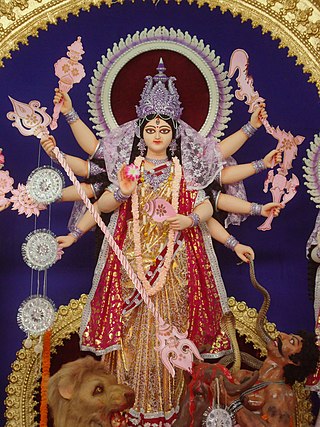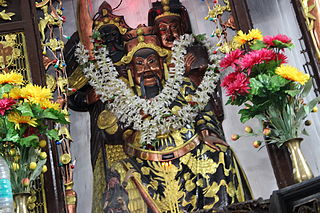History
The bazaar is named after Edoardo Tiretta, [7] an Italian immigrant from Venice, who was a land surveyor and owner in the area during late 18th-century. [8]
During the time of Warren Hastings, the first governor-general of British India, a businessman by the name of Tong Achew established a sugar mill, along with a sugar plantation at Achipur, 33 kilometres (21 mi) from Calcutta, on the bank of the Hooghly River near the town of Budge Budge. [9] A temple and the grave of Tong Achew still remain and are visited by many Chinese Indians, who arrive from the city to celebrate Chinese New Year. [9]
One of the earliest records of immigration to India from China can be found in a short treatise from 1820. This records hints that the first wave of immigration was of Hakkas but does not elaborate on the professions of these immigrants. According to a later police census, there were 362 Chinese in Calcutta in 1837. A common meeting place was the Temple of Lord Guan, the Martial God of Loyalty & Righteousness, located in the Chinese quarter near Dharmatolla. [10] A certain C. Alabaster mentions in 1849 that Cantonese carpenters congregated in the Bow Bazar Street area. [10] As late as 2006, Bow Bazar is still noted for carpentry, but few of the workers or owners are now Indians of Chinese origin.
According to Alabaster, there were lard manufacturers and shoemakers in addition to carpenters. Running tanneries and working with leather were traditionally not considered "respectable" professions among upper-caste Hindus, and work was relegated to the so-called "lower caste" muchis and chamars . Nevertheless, there was a significant demand for high quality leather goods in colonial India, which Chinese Indians were able to fulfill. Alabaster also mentions "licensed" opium dens, run by "native Chinese" and a "Cheena Bazaar", where "contraband" was readily available. Opium, however, was not illegal until after India's Independence from Great Britain in 1947. Immigration continued freely through the turn of the century and during World War I partly due to political upheavals in China, including the First and Second Opium Wars, the First Sino-Japanese War and the Yihetuan Movement. Around the time of the First World War, the first Chinese-owned tanneries sprang up. [10]

Chinatown is the catch-all name for an ethnic enclave of Chinese people located outside Greater China, most often in an urban setting. Areas known as "Chinatown" exist throughout the world, including Europe, Asia, Africa, Oceania, and the Americas.

Kolkata, also known as Calcutta, is the capital and largest city of the Indian state of West Bengal. It lies on the eastern bank of the Hooghly River, 80 km (50 mi) west of the border with Bangladesh. It is the primary financial and commercial centre of eastern and northeastern India. Kolkata is the seventh most populous city in India with an estimated city proper population of 4.5 million (0.45 crore) while its metropolitan region Kolkata Metropolitan Area is third most populous metropolitan region of India with a metro population of over 15 million. Kolkata is regarded by many sources as the cultural capital of India and a historically and culturally significant city in the historic region of Bengal.

Chinatowns in Asia are widespread with large concentrations of overseas Chinese in East Asia and Southeast Asia, and ethnic Chinese whose ancestors came from southern China — particularly the provinces of Guangdong, Fujian, and Hainan — and settled in countries such as Brunei, Cambodia, East Timor, Indonesia, India, Laos, Malaysia, Myanmar, the Philippines, Singapore, Sri Lanka, Thailand, Vietnam, Japan and Korea centuries ago — starting as early as the Tang dynasty, but mostly notably in the 17th–19th centuries, and well into the 20th century. Today the Chinese diaspora in Asia is primarily concentrated in Southeast Asia; however, the legacy of the once widespread overseas Chinese communities in Asia is evident in the many Chinatowns found across East, South and Southeast Asia.

Tangra is a region in East Kolkata that traditionally housed many tanneries owned by people of Hakka Chinese origin.

Kolkata, India, is largely inhabited by the ethnic community of the native Bengalis respectively. According to a report by the Indian Statistical Institute owned by the Government of India, the Kolkata city had a population of 4.5 million as of 2011 out of which the population of native Bengalis in Kolkata is almost 62% which comprised the majority of the city's population, whereas ethnic groups like Marwaris, Biharis and Urdu-speaking Muslims together forming 36% of the population which comes under the category of large minorities. Other Various micro-minority communities of Kolkata include as far as concerned follows -: Pathans, Marathis, Odias, Gujaratis, Sindhis, Kashmiris, Punjabis, Nepalis, Telugus, Tamils, Anglo-Indians, Iraqis, Jews, Armenians, Tibetans, Greeks, Parsis, Chinese, and Iraqis etc.

Indian Chinese cuisine, Chinese Indian cuisine, Indo-Chinese cuisine, Sino-Indian cuisine, Chindian cuisine, Hakka Chinese or Desi-Chinese cuisine is a distinct style of Chinese cuisine adapted to Indian tastes, combining Chinese foods with Indian flavours and spices. Though Asian cuisines have mixed throughout history throughout Asia, the most popular origin story of the fusion food resides with Chinese labourers of Calcutta, who immigrated to British India looking for work. Opening restaurant businesses in the area, these early Chinese food sellers adapted their culinary styles to suit Indian tastes.

Behala is a locality of South West Kolkata in the Indian state of West Bengal. Behala is a part of Kolkata Municipal Corporation area. It is broadly spread across Ward Nos. 118, 119, 120, 121, 122, 123, 124, 125, 126, 127, 128, 129, 130, 131 and 132 of the Kolkata Municipal Corporation and is divided into two Vidhan Sabha constituencies: Behala Paschim and Behala Purba. This area is served by the South West Division of Kolkata Police also known as Behala Division.

Garia is a neighbourhood of South Kolkata in the South 24 Parganas district in the Indian state of West Bengal. It is bordered by the neighbourhoods of Jadavpur in the north, Bansdroni/Tollygunge in the north-west, Santoshpur/Mukundapur in the north-east and Narendrapur/Rajpur Sonarpur in the south. It is on the banks of Adi Ganga.
Chinese people in India are communities of Han Chinese and Tibetan origin and settlement. There are permanent communities descended from immigrants and refugees from China as well as an expatriate community in India on a temporary basis.

Bowbazar, also spelt Boubazar; formerly known as Bahubazar) is a neighbourhood of Central Kolkata, in Kolkata district in the Indian state of West Bengal.

Entally is a neighbourhood of Central Kolkata, in Kolkata district in the Indian state of West Bengal. It was considered close to the area which was home to the poor and the depressed castes. Mother Teresa started her activities in Entally.

Burrabazar is a neighbourhood of Central-North Kolkata, in Kolkata district in the Indian state of West Bengal.

Chinese temples are associations (會館) and sites of worship of Chinese folk religion and Chinese Buddhism for the Chinese community in Kolkata. Kolkata has a significant population of Indian nationals of Chinese ethnic origin. Unofficial estimates puts the population of Indian nationals of Chinese-origin in Kolkata anywhere from 5,000 to 200,000, most of whom live in or near Tangra. The Chinese brought with them their culture. At least eight of the Chinese temples are located in the old Chinatown around Tiretta Bazar in Central Kolkata.

Tiljala is a neighbourhood of East Kolkata, in West Bengal, India.

Topsia is a neighbourhood of East Kolkata, in West Bengal, India. Topsia falls in Kolkata district situated in West Bengal state, with a population 94809. The male and female populations are 49388 and 45421 respectively. The size of the area is about 2.8 square kilometer.
Ward No. 44, Kolkata Municipal Corporation is an administrative division of Kolkata Municipal Corporation in Borough No. 5, covering parts of Burrabazar (Mechhua), Tiretta Bazaar, Kolutola(Colootola Street) and College Street neighbourhoods in north-central Kolkata, in the Indian state of West Bengal.
Ward No. 57, Kolkata Municipal Corporation is an administrative division of Kolkata Municipal Corporation in Borough No. 7, covering parts of Tangra, Chingrighata and East Kolkata Wetlands (Makaltala-Chailabi) neighbourhoods in central-east Kolkata, in the Indian state of West Bengal.

Gobinda Chandra Khatick Road is a famous thoroughfare in the city of Kolkata, India. The road runs past Grace Ling Liang Church, Tangra Police Station, and largely through the China Town areas of Tangra in East Kolkata and crosses Pulin Khatik Road and Christopher Road at separate intersections. Gobinda Chandra Khatik road is 2.1 kilometers in length from the Tangra Slaughterhouse to the Topsia Junction. It demarcated the Eastern Fringes of the city at a time when Chinese operated Tanneries and Leatherworks dominated the area. Nowadays, China Town is a haven of Indo Chinese Fusion food and has crafted a legacy in its own right. Initially called Hughes Road until 1985, the name was renamed to recognise the contribution of Late Gobinda Khatik. Recent Urbanization and rapid growth has rapidly changed the landscape of Tangra and traffic snarls on the once empty road are common. The road is long and narrow and caters to Bi-Directional traffic. Dhangars, a community of Untouchable sanitary workers established their colony along this road. The road falls under Ward no. 56, 59, and 66 of the KMC.

Lee Youn Chin was a Chinese Hakka community leader in India for over half a century. Lee was instrumental in founding the Chinese Tannery Owners Association of India, the newspaper Seong Pow, and the new Pei May High School. These institutions for commerce, education, and journalism had a profound impact on the Hakka Chinese settlement in Kolkata, India.

Count Edoardo Tiretta, often anglicized to Edward Tiretta, was a Venetian nobleman, architect and landowner. Part of Giacomo Casanova's set in Paris, he moved to Calcutta in his forties, where he worked as a civil architect, building superintendent and land surveyor. He notably built Tiretta Bazaar, which became India's first Chinatown.























